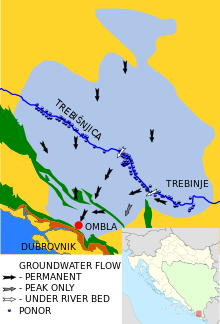
The Trebišnjica (Serbian Cyrillic: Требишњица) is a river in Bosnia and Herzegovina, and the right tributary of the Neretva. Before it was utilized for hydro exploitation via various hydrotechnical interventions and systems with different purposes, Trebišnjica used to be a sinking river, rising and sinking through its course before resurfacing at various places from the Neretva river below the Čapljina to the Adriatic coast, and along the coast from the Neretva Delta to Sutorina.
With a total length of 96.5 km (60.0 mi) above the ground, and roughly another 90 km (56 mi) below the surface, the Trebšnjica river is one of the longest sinking rivers in the world with the total of 187 km (116 mi) above and under the ground.[1][2] In hydrological terms, it represents a sub-basin within the Neretva river basin.
In classical antiquity, the river was known as the Arion,[3]
The Trebišnjica river originate near town of Bileća. The source of the river is a system of strong karstic wellsprings distributed in two principal aquifer zones, geographically and hydrologically distinct albeit in relatively close proximity to each other. In both zones group of wellsprings raises from the underground, consisting of a number of large, abundant founts each.[4]
The first, at the head of the river and at the outskirts of Bileća town, is the Trebišnjica wellsprings group, consisting of three large wellsprings, with Dejanova Pećina as primer outflow, and two secondary ones, wellspring Oko and Nikšičko Vrelo.[4][5]
The second zone, Čepelica river spring-group ("Čeplica spring-group") at Ćeplica village, is located 3.25 kilometres (2.02 mi) further down the stream from first group. The Čepelica spring-group consists of two main karst hydrological features, Wellspring Čepo (Vrelo "Čepo") with three main outlets, and group of smaller estavelles (sinkholes) and springs on the left-bank side of the Čeplica river streambed.[4][5]
Formation of the Bileća Lake has affected the region significantly, both underground as well as at the ground level, with the extent of ecological impact still, after several decades, not being fully assessed.[6] Entire system of the Trebišnjica wellsprings, its both groups, were part of the characteristic Dinaric karst landscape, with significant aesthetic value. However entire area surrounding the Trebišnjica river, its headwaters with sources, Miruška valley, Popovo Polje, many villages and productive land is flooded in 1967 by the Bilećko Lake, formed after construction of the Grnčarevo dam, with the primary purpose of serving as an artificial water reservoir for the Trebinje-1 Hydroelectric Power Station turbines.[6][7]
As it flows in an area of karst (limestone), the Trebišnjica actually represents a very complex system of the above and underground streams. It originates in Bosnia and Herzegovina from two streams from the Lebršnik and Čemerno mountains:
The river shortly re-appears in the Fatničko Polje, where the village of Fatnica is largest settlement, under the name of Fatnička rijeka (River of Fatnica), only to sink again after a short flow above the ground.

After a total underground flow of some 30 km (19 mi), the waters of the sinking Fatnička rijeka re-appear as a series of very powerful cave springs near the town of Bileća, which are joined into one river, the Trebišnjica, the most important river in eastern Herzegovina. The river flows to the south, through the depression of Miruša. On the southernmost part of the depression, the river is dammed by the Grancarevo Dam at the village of Gornje Grančarevo and completely flooded upstream by the artificial Lake Bileća. Nearly all of the eastern bank of the lake belongs to Montenegro.
The Trebišnjica turns west between the villages of Donje Grnčarevo and Lastva into the Trebinjsko polje (Field of Trebinje), being dammed again at Gorica, with a small reservoir. The river continues to the west following the southern slopes of Bjelasnica mountain, through the town of Trebinje and villages of Dražin Do, Tvrdoš, Gornja Kočela and Donja Kočela, and enters the largest karst field in the Balkans, Popovo Polje (Priest's Field).
In Popovo Polje, the Trebišnjica used to sink (see Regulation below), right after the Trebinje. In the field, the river turns northwest, next to the villages of Staro Slano, Đedići, Dobromani, Žakovo, Tulje, Sedlari, Grmljani and Zavala, near the Vjetrenica cave, the largest in Bosnia and Herzegovina. The river then turns north, curves between the villages of Dvrsnica, Orašje, Čavaš and Turkovići and in the lower Popovo Polje, near the Croatian border, sinks into the several big sinking holes (most notably, the Doljašnica and Ponikva holes.

The waters of the Trebišnjica from the Popovo Polje, re-appear as three separate outflows:
The total drainage area of the Trebišnjica covers 4,926 km2 (1,902 sq mi), of which 600 km2 (230 sq mi) is shared with the Neretva drainage area (the spring of Čapljina). The drainage area of the central, longest part of the river covers 2,225 km2 (859 sq mi).

As a river that flows in geologically unstable terrain (karst) and with such an interrupted flow, the Trebišnjica contains enormous potential for hydroelectricity production. As a result, regulatory works on the Trebišnjica were arguably the most massive ones in the former Yugoslavia.